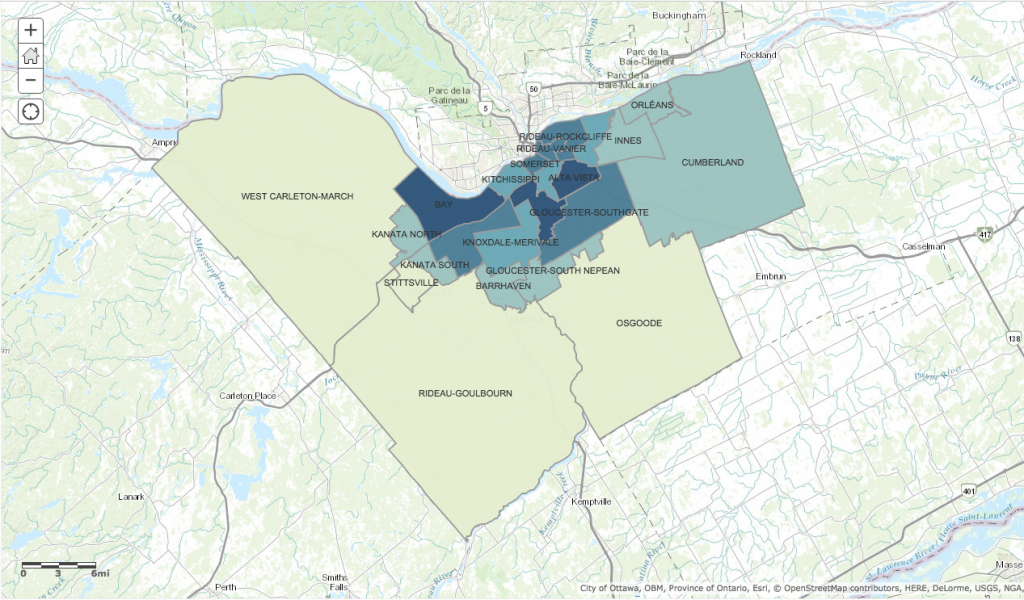By Amy Thatcher
A large number of people in Canada’s capital are living in over-crowded homes deemed “unsuitable”, according to National Household Survey (NHS) data from 2011.
Over 20,000 homes are classified as being unsuitable in the City of Ottawa, meaning they don’t have enough bedrooms for the number of people and size of the space, according to NHS guidelines.
And certain wards—Alta Vista, River and Bay in particular—have more overcrowding than others. West Carleton and Osgoode wards have the lowest numbers of unsuitable homes.

(http://arcg.is/1OUacCX)
The definition of suitable housing used by the NHS is derived from part of the Canada Mortgage and Housing Corporation’s (CMHC) definition, which takes into account three aspects: affordability, adequacy (physical condition), and suitability (overcrowding).
“The NHS definition in particular has to do with the element of overcrowding, where people are trying to stretch their housing dollars,” says Fran Klodawsky, a Carleton University professor specializing in affordable housing.
Suitability is further defined by CMHC’s National Occupancy Standard requirements, which specify that houses must have at least one bedroom per adult couple, per person over the age of 18, per same-sex pair of children under the age of 18, and per additional child.
“More crowding in the Alta Vista, River and Bay wards could be a function of more apartments with lower income families crowded in,” says Steve Pomeroy, an urban planning consultant in Ottawa. “It could be as simple as a kid sharing a room with mum, or with a sibling of the opposite sex.”
He also indicated that these wards increasingly house larger minority families which may have different cultural norms than those we have adopted, and they may not consider sharing rooms inappropriate.
“Oftentimes, multi-generational families live under the same roof,” he says. “Grandparents live with their children and their grandchildren, sometimes even aunts uncles and cousins.”
Alta Vista River and Bay wards also have a disproportionately higher number of social housing units, according to Pomeroy.
While regulations do exist to combat overcrowding in subsidized social housing in Ottawa, the City’s suitability guidelines are based on square feet per person—not on the number of rooms.
Trudy Sutton, executive director of Ottawa’s Housing Help says that housing is deemed suitable if it has 100 square feet of bedroom space per person.
“This doesn’t necessarily line up with the NHS guidelines governing suitability,” she says. “Suitability depends on your definition.”
So, housing that is classified as unsuitable in the NHS may pass the City’s regulations. This means the amount of unsuitable housing in Ottawa could be much lower than data suggests.
Klodawsky confronted this discrepancy in definitions, asking—who decides what’s deemed unsuitable?
“There are tradeoffs, having just boys versus boys and girls versus having three kids in a room doesn’t always matter,” says Klodawsky. “If it means the parents are not as far away from their work than if they were living in the boonies, then maybe it’s reasonable.”
While regulations do exist to prevent overcrowding, the issue is not enforced regularly by City of Ottawa bylaw. Klodawsky says housing enforcement is mostly around major physical repair rather than the number of people per residence.
She says this could be because crowding is not necessarily a safety issue. Sutton did say however, that overcrowding is something that can affect one’s health.
“If you’ve got a bunch of siblings and mom and dad in a very limited number of rooms, it can affect sleep and the general health of everyone.”
A CMHC overview of housing suitability in Canada, based on 2011 National Household Survey data:



